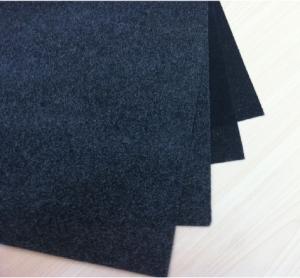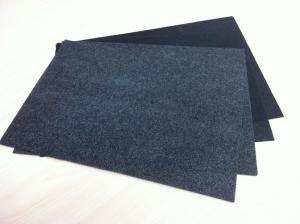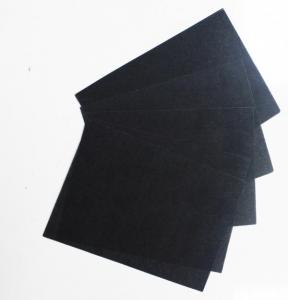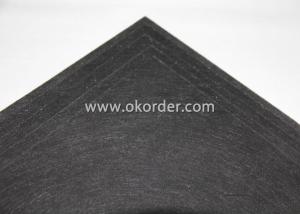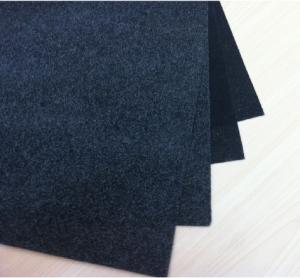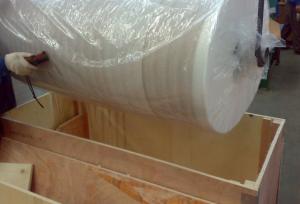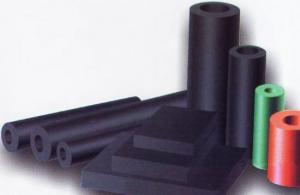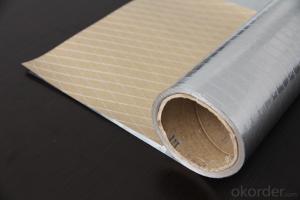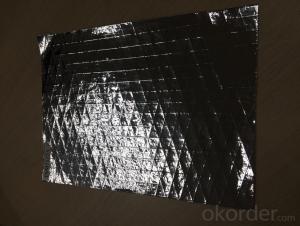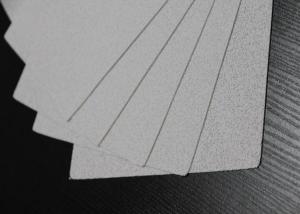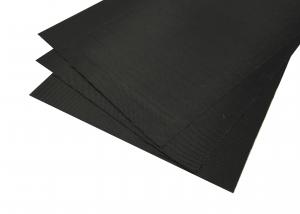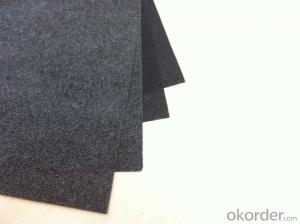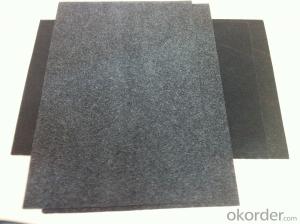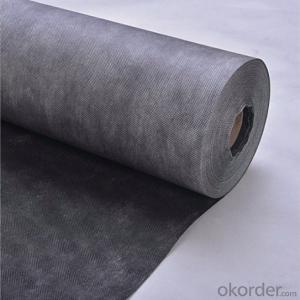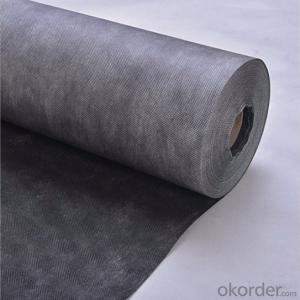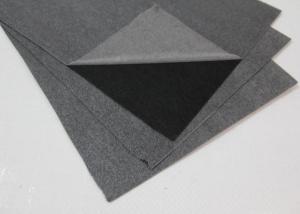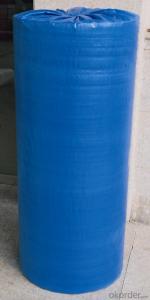Black Fiberglass Tissue-BFT001-65E
- Loading Port:
- China Main Port
- Payment Terms:
- TT or L/C
- Min Order Qty:
- 10000M2 m²
- Supply Capability:
- 50000M2 Per Week m²/month
OKorder Service Pledge
OKorder Financial Service
You Might Also Like
Specifications of Black Fiberglass Tissue
|
Specification | ||
|
ITEM |
UNIT |
VALUE |
|
Type |
|
E |
|
Weight |
g/m2 |
65±5 |
|
Thickness |
mm |
0.40 |
|
Tensile Strength MD |
n/5cm |
≥130 |
|
Tensile Strength XD |
n/5cm |
≥90 |
|
Fiber Diameter |
µ |
9 |
|
Fire Resistant Property |
|
B1 |
SIZE:
Width: 0.6m---1.3m
Length: 100m-1000m
Core I.D.: 3"(76mm ±1)
Based on order, special sizes are also available.
MSDS:No harm for body and environment, non-volatile product.
Remarks:
1. The data above are typical results and subject to change without notice.
2. Tolerance: Weight and Thickness: ±10%; Width: ±3mm; Length: ±0.5%.
3. The products should be stored at room temperature, kept from wet and kept away heat source.
4. Good appearance without stain, oxidation, mildew.
5. The users should take test and do trial-application on the above products before coming into application so as to witness and ensure suitability for their special purpose and technique.
Usage/Applications of Black Fiberglass Tissue
Fiberglass facing is good at fireproof, mildew resistant, damp proof and strong air permeability. After laminated with glass wool or rock wool, the physical properties is excellent such as heat preservation, noise elimination, fire retardant, extinction, etc.
Packaging & Delivery of Black Fiberglass Tissue
Each roll is packed by the water-proof film
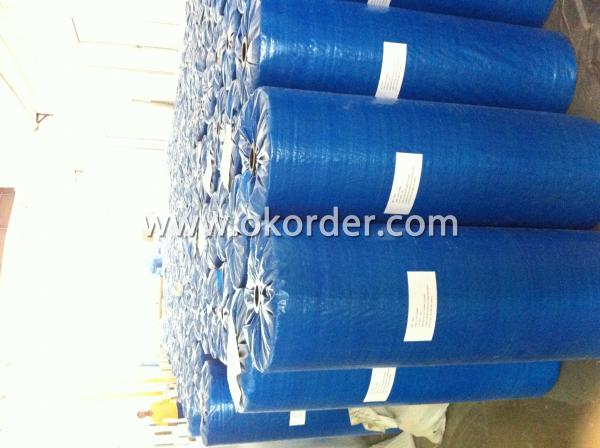

- Q:Is fiberglass facing fire-resistant?
- Yes, fiberglass is considered fire-resistant. It is made from a combination of glass fibers and resin, which gives it excellent heat resistance properties. Fiberglass can withstand high temperatures without melting or releasing toxic fumes. It is often used in applications where fire resistance is important, such as insulation, protective clothing, and construction materials. However, it's important to note that while fiberglass itself is fire-resistant, the materials it is used with, such as adhesives or coatings, may affect its fire-resistance properties.
- Q:Can fiberglass facing be used in both residential and commercial buildings?
- Fiberglass facing is applicable for use in both residential and commercial buildings. This versatile material offers numerous advantages, including thermal insulation, moisture resistance, and soundproofing. Its diverse properties make it suitable for various applications in both residential and commercial settings. In residential buildings, fiberglass facing can be utilized in insulation products for walls, ceilings, and attics. By doing so, it contributes to the enhancement of energy efficiency and reduction of heating and cooling expenses. Furthermore, it can be integrated into residential HVAC systems to improve air quality and minimize noise transmission. Similarly, in commercial buildings, fiberglass facing can be incorporated into insulation products for walls, roofs, and HVAC ductwork, providing the same benefits as in residential settings. Moreover, it can be utilized in commercial acoustic panels and soundproofing systems to diminish noise levels in offices, conference rooms, and other commercial spaces. Overall, fiberglass facing is an adaptable material that effectively enhances insulation, moisture resistance, and soundproofing properties in both residential and commercial buildings.
- Q:Is not the multi-layer membrane waterproof, the bottom of the membrane should use glass fiber mats?
- No, just fiberglass felt tread cloth soft
- Q:Can fiberglass facing be painted or customized?
- Yes, fiberglass facing can be painted or customized.
- Q:How is fiberglass facing installed?
- Installing fiberglass facing typically involves a few simple steps. Firstly, ensure that the surface where the fiberglass will be placed is clean, dry, and free from any dust or debris. This is important to ensure that the facing adheres properly. Next, carefully unroll the fiberglass facing and cut it to the desired size, leaving some extra material on each side for complete coverage. Position the facing over the surface and firmly press it down, starting from the center and moving towards the edges. To securely hold the fiberglass facing in place, apply adhesive or adhesive tape along the edges to create a tight seal. Smooth out any wrinkles or air bubbles that may have formed during installation. In certain situations, mechanical fasteners like staples or nails may be necessary to further strengthen the fiberglass facing, especially in areas prone to high impact or requiring extra reinforcement. Overall, installing fiberglass facing is a relatively straightforward process that demands attention to detail and proper surface preparation. By following these steps, you can ensure a successful installation that offers durability and protection.
- Q:Can fiberglass facing be recycled?
- Yes, fiberglass facing can be recycled. Fiberglass is a type of reinforced plastic made from fine fibers of glass, and the facing is typically a thin layer of fiberglass. While recycling fiberglass can be more challenging than other materials due to its unique properties, it is still possible to recycle it. The recycling process involves shredding or grinding the fiberglass material into small pieces, which can then be used to make new products. However, it is important to note that the recycling infrastructure for fiberglass may not be as widespread or easily accessible as for other materials, so it is advisable to check with local recycling facilities or specialized fiberglass recycling companies to understand the specific recycling options available in your area.
- Q:How does fiberglass facing compare to other types of insulation materials?
- Fiberglass facing is a popular choice for insulation materials due to its numerous advantages over other types of insulation. Firstly, fiberglass facing offers excellent thermal insulation properties, helping to maintain a comfortable temperature inside buildings by minimizing heat transfer. It has a high R-value, which means it provides effective resistance to heat flow. Additionally, fiberglass facing is highly durable and long-lasting. It does not degrade or lose its insulating properties over time, ensuring that it remains effective for many years. This durability also makes it resistant to moisture, mold, and pests, which can be a common issue with other insulation materials such as cellulose or foam. Furthermore, fiberglass facing is easy to install, reducing both time and labor costs. It is available in various forms like batts, rolls, or loose-fill, making it adaptable for different applications and spaces. Its lightweight nature makes it easy to handle and maneuver during installation. One of the key advantages of fiberglass facing is its fire resistance. It is non-combustible, meaning it does not contribute to the spread of fire and can help contain it. This property makes it a safer choice compared to other insulation materials like foam, which can be flammable. Lastly, fiberglass facing is an environmentally friendly option. It is made from natural materials such as sand and recycled glass, reducing its impact on the environment. Additionally, fiberglass insulation can help conserve energy and reduce carbon emissions by improving the energy efficiency of buildings. Overall, fiberglass facing stands out as an excellent choice for insulation materials due to its thermal insulation properties, durability, ease of installation, fire resistance, and eco-friendliness. It outperforms many other types of insulation materials, making it a preferred option for various construction and insulation projects.
- Q:China's glass fiber product code is what?
- Will be replaced by N or K, respectively, said ND-8, KH-550; ④ EM will be used instead of CM, said the alkali fiberglass
- Q:What is the glass fiber needle felt dust filter bag
- Glass fiber needle felt dust filter bag is a high temperature dust bag, is a reasonable structure, better performance of the filter material to glass fiber as raw material
- Q:How is fiberglass facing used in construction?
- Construction commonly utilizes fiberglass facing as a safeguard for insulation materials, effectively applying it to the outer side of insulation boards or blankets. This facing is crafted from woven fiberglass fabric or reinforced foil, bolstering the insulation's sturdiness and resilience. A primary function of fiberglass facing in construction is to serve as a vapor barrier, effectively thwarting moisture from permeating the insulation and reducing the likelihood of condensation and mold growth. By maintaining the insulation's dryness, its thermal capacity endures and its lifespan is prolonged. Furthermore, fiberglass facing also functions as a radiant barrier, reflecting radiant heat and thereby minimizing heat transfer between the surroundings and the insulation. This attribute proves especially advantageous in warm climates or when insulating buildings that receive direct sunlight exposure. Moreover, fiberglass facing enhances the mechanical properties of insulation materials, providing structural reinforcement and guarding against harm during handling, transportation, and installation. It also heightens the insulation system's fire resistance by acting as a shield against flames and curtailing the spread of fire. To summarize, fiberglass facing is an adaptable component employed in construction to augment the performance and longevity of insulation materials. It acts as a vapor barrier, radiant barrier, and protective layer, ensuring that buildings possess effective insulation, energy efficiency, and safety.
1. Manufacturer Overview |
|
|---|---|
| Location | Jangsu, China |
| Year Established | 1999 |
| Annual Output Value | Above US$0.3 billion |
| Main Markets | 0.00% Mid East 15.00% Northern Europe 15.00% North America 10.00% Eastern Asia 20.00% Africa 0.00% Eastern Europe 20.00% Southeast Asia 0.00% Oceania 0.00% Western Europe 0.00% Southern Europe 0South east asia;North America |
| Company Certifications | ISO 9001:2008 |
2. Manufacturer Certificates |
|
|---|---|
| a) Certification Name | |
| Range | |
| Reference | |
| Validity Period | |
3. Manufacturer Capability |
|
|---|---|
| a)Trade Capacity | |
| Nearest Port | Shanghai |
| Export Percentage | 41% - 50% |
| No.of Employees in Trade Department | 20 People |
| Language Spoken: | English; Chinese |
| b)Factory Information | |
| Factory Size: | Above 100,000 square meters |
| No. of Production Lines | Above 4 |
| Contract Manufacturing | OEM Service Offered; Design Service Offered |
| Product Price Range | Average |
Send your message to us
Black Fiberglass Tissue-BFT001-65E
- Loading Port:
- China Main Port
- Payment Terms:
- TT or L/C
- Min Order Qty:
- 10000M2 m²
- Supply Capability:
- 50000M2 Per Week m²/month
OKorder Service Pledge
OKorder Financial Service
Similar products
New products
Hot products
Hot Searches
Related keywords
